
Jeroen Meeusen
A collection of 19th century Continental microscopes
and related items
Showing results for ""
No results
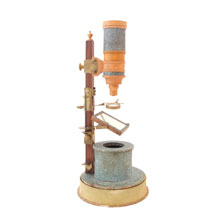
1800-12
Bernardino Marzoli
microscopio acromatico solare
Brescia, Italy
Microscope by Bernardino Marzoli (1748-1835) with an achromatic plano-convex objective lens ground according to his 1808 paper "Sul modo di costruire le lenti acromatiche obbiettive dei microscopi composti".
The base has an intriguing signature: "Domenico Coccoli Fécit e inv. in Brixia". Domenico Cocoli (1747-1812) was a mathematics professor at the Lyceum of Brescia, from 1797 until at least 1807. In 1805 and 1808, Marzoli was recorded as "Conservatore del Gabinetto di Fisica" at the very same institution. The ink signature is not in the handwriting of Cocoli. Moreover, Cocoli invariably wrote his surname as "Cocoli" and not as "Coccoli". It therefore appears that the signature is incorrect.
The open circular base may have allowed a transformation into a solar microscope by mounting it onto a camera obscura. Marzoli exhibited such a combination in 1825 and donated it in 1834.
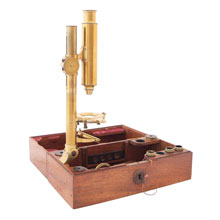
1812-4
Joseph Fraunhofer
zusammengesetztes Microscop, mit [...] vier achromatischen Objectiven [...] nebst Kästchen
Benediktbeuern, Germany
Early example of Fraunhofer's box-mounted achromatic microscope, made between November 1812 and February 1814. Signed on the stage "Utzschneider, Reichenbach, Fraunhofer in Bendictbeurn [sic]".
With the publication of his 1811 price list, Joseph Fraunhofer (1787-1826) was the first to truly commercialise an achromatic microscope. In fact, this list only offered one single compound microscope that was either available with uncorrected "einfachen Linsen" (E: simple lenses) or more expensive "achromatischen Linsen". The objective lenses of this microscope are achromatic and of a type nowadays named after Fraunhofer: an air-spaced bi-convex doublet.
As with all pre-Selligue dioptric achromatic microscopes, Fraunhofer's were of low power and no real improvement over an uncorrected compound microscope.
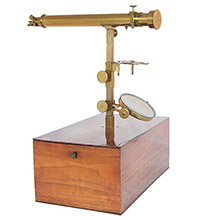
1819-22
Giovanni Battista Amici
microscopio a riflessione / microscopio catadiottrico
Modena, Italy
Reflecting or catadioptric microscope by G. B. Amici (1786-1863). Signed on the end of the tube: "Amici, Modena".
As it proved impossible to grind exceedingly small lenses with the required accuracy to form a high power achromatic lens-pair, in 1812 Amici turned his attention to the construction of reflecting microscopes. Reflectors are in principle free of aberrations, but difficult to fabricate. By 1818, Amici had developed a standardised form of his reflecting microscope, which he sold in quite considerable numbers. Amici's reflecting microscope truly represented an improvement over the uncorrected compound microscope.
It was only after being acquainted with Fresnel's 1824 favourable report on Selligue's microscope that Amici returned his attention to the fabrication of achromatic lens-pairs and eventually abolished the production of reflecting microscopes in 1829.
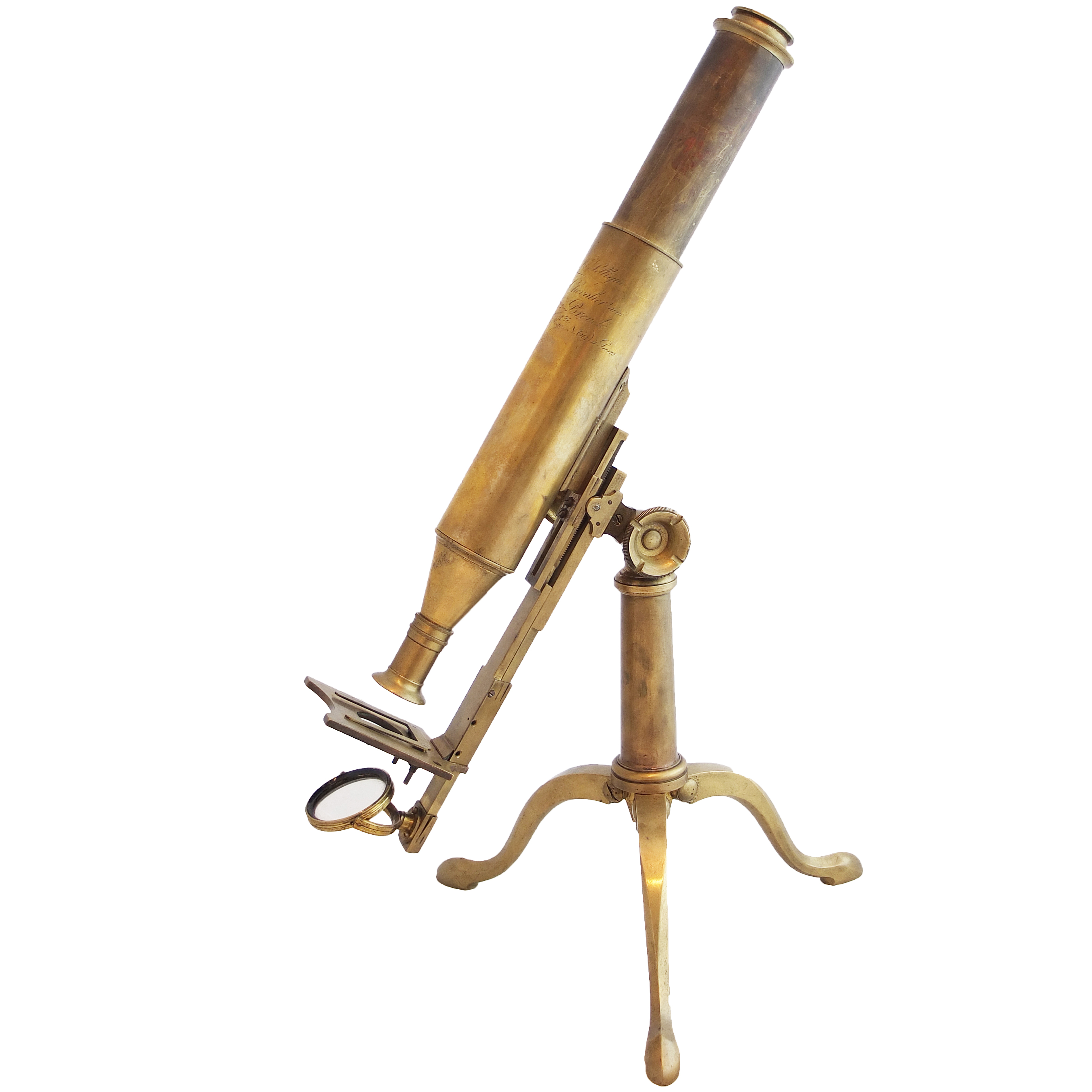
1824-5
Vincent Chevalier
microscope de Selligue
Paris, France
Selligue microscope by Vincent Chevalier (1770-1841), modernised by Hugh Powell (1799-1883) in the early 1830s. Most likely the instrument of the London surgeon John Howship (1781-1841). Signed on the tube "Selon M[onsieu]r Selligue, par Vincent Chevalier ainé, Ing[énieu]r Opt[ici]en Breveté, quai de L'horloge № 69 à Paris."
After returning from Geneva to his hometown Paris, Alexandre François Gilles a.k.a. Selligue (1784-1845), presented on April 5th 1824 to the French Academy of Sciences an achromatic microscope of "great simplicity. It is made up of two achromatic objectives which can be used simultaneously or separately". It was Selligue's explicit wish to make a microscope "that can be compared with that of Mr. Amici in all respects and does not have a single component that can not be made in all ordinary optical workshops." It was the 'ordinary optical workshop' of Vincent Chevalier that made the microscope presented by Selligue to the Academy.

circa 1826
Robert Aglaé Cauchoix
microscope de Selligue
Paris, France
Selligue microscope by Cauchoix. Signed on the tube "Cauchoix Opticien, à Paris".
In the introduction of the 1824 report on Selligue's achromatic microscope, Augustin Fresnel expressed his surprise that "up till now opticians have not applied achromatic combinations to microscopes, which they have been using for a long time for telescopes". Fresnel concluded that "Even though the new microscope is not equal to that of Amici in all respects, it nevertheless renders an important service to science by providing an instrument almost as perfect [...] that can be produced by ordinary methods, and which costs only 340 francs, while the price of the microscopes of Amici is 800 francs."
The present microscope shows that one of the two major Parisian manufacturers of achromatic telescopes - Cauchoix - did take up the production of achromatic microscopes after Selligue paved the way.
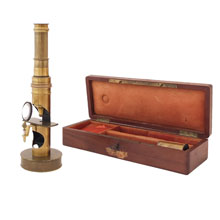
1829-31
Bouquet & Georges Oberhaeuser
microscope de M. Trécourt
Paris, France
Signed on the tube: "Bouquet et Georges Oberhaeuser, à Paris."
In about 1829, Achille Trécourt, a clerk in the French Ministry of War, designed what was - arguably - the first true low cost achromatic microscope. Trécourt entrusted the fabrication of the lenses of his 'microscope achromatique réduit' to Bouquet and the brasswork to the mechanical engineer Oberhäuser.
Contrary to later models, fine focusing in this example is not by tilting the stage, but is accomplished by turning a knurled sleeve in the middle of the tube.
The inside of the mirror cell is signed: "N° 19 Pour Mr Briquet". The name might refer to the Parisian physician and psychologist Pierre Briquet (1796-1881). Number 19 is a batch number stamped on different parts of the microscope.
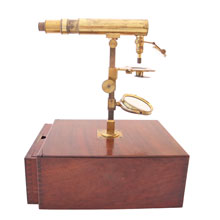
end of 1830
Vincent & Charles Chevalier
microscope d'Amici
Paris, France
Horizontal microscope by Vincent & Charles Chevalier, in contemporary literature referred to as 'microscope d'Amici' (Amici type microscope). Signed on the tube "Vincent & C. Chevalier Ing[énieu]rs Opt[icie]ns, Quai de l'horloge № 69 à Paris" and on the tube cradle "CH. CHEVALIER, 154"
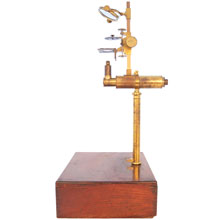
1834-5
Charles Chevalier
microscope chimique
Paris, France
An horizontal microscope that can be inverted for chemical use by Charles Chevalier (1804-1859). Most likely the instrument of Jean-Baptiste Biot (1774-1862). Signed on the tube: "Microscope Achromatique de Charles Chevalier, Ingénieur Opticien Breveté, Palais Royal 163 à Paris".
At the request of Félix Savart (1791-1842), Chevalier developed a new ‘universal’ microscope for the Collège de France, which was exhibited at the 1834 French Industrial Exposition. Shortly afterwards, Chevalier made a similar horizontal microscope for Biot that was "exclusively intended for chemical experiments". A second example of this new chemical microscope was made for Jean-Baptiste Dumas (1800-1884).
A label on the inside of the box states: "Vendu par Teigny, quai des Orfèvres 50. provenant du Dr de Brière, rue de La motte piquet." Adolphe-Louis Teigny was a retailer of scientific instruments active between 1855 and 1869. Dr de Brière remains unidentified.

1832-43
Achille Trécourt & Georg - Georges - Oberhaeuser
a myriad of 'microscopes achromatiques réduits'
Paris, France
Signed: "Trécourt & Georges Oberhaeuser, Place Dauphine № 19, Paris".
In about 1829, Trécourt formed a partnership with Oberhaeuser (mechanic) and Bouquet (optician) to make a cheap achromatic microscope. With great success: batch numbers on these microscopes are as high as 50, indicating that they were produced in large series.
In 1848, Oberhaeuser wrote to Pieter Harting: "if I ever rendered a service to science, it was by being the first to make inexpensive microscopes, so that scientists who are usually not rich can more easily open their wallet".
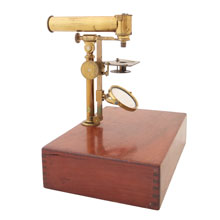
1837
Charles Chevalier
microscope universel petit modèle
Paris, France
In 1834, Charles Chevalier presented his 'universal microscope' that could be arranged as a vertical, horizontal and inverted (chemical) microscope. Its high price, however, was subject to criticism.
Chevalier took the criticism to heart and introduced in 1837 a smaller and cheaper universal model, based on his existing small 'simple and compound model'. He kept the tube, stage, mirror and optics, but added a second column, as well as two joints and a prism. Ironically, the resulting small universal model could be transformed into a simple microscope as well, contrary to the original and much more expensive large model.
In comparison to this very early unsigned example, later production models were one-third larger in size, had a drawtube, a double sided mirror, a stage that could be inverted and removable nosepieces.
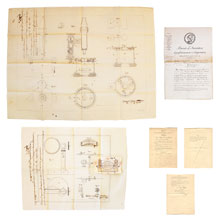
August & October 1837
Achille Trécourt & Georg - Georges - Oberhaeuser
demande de brevet d'invention & brevet d'invention définitif
Paris, France
Patent application by Georges Oberhaeuser (Georg Oberhäuser) and Achille Trécourt for a "microscope achromatique vertical à miroir fixe avec platine à tourbillon...". Dated 17th August 1837.
In the margin of the first page of the patent application is written "Expédition". The example held by the Institut national de la propriété industrielle in Paris is marked on the very same location "Minute". It therefore appears that the present document was sent by the patent office to the applicants.
Final patent for a 5-year term, dated 13th October 1837.
Provenance: Marc Loury (1935-2014), great-grandson of Alfred Nachet (1831-1908).
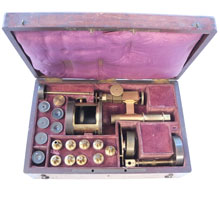
circa 1837
Achille Trécourt & Georg - Georges - Oberhaeuser
microscope à tourbillon
Paris, France
Signed on the drum base "Brevet d'Invention, Trécourt & Georges Oberhaeuser, Place Dauphine № 19 à Paris". Trécourt and Oberhaeuser took out a patent for this 'microscope à tourbillon' in 1837.
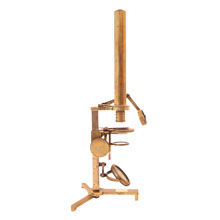
August 1839
Giovanni Battista Amici
piccolo microscopio acromatico d'Amici acquistato dal S.r Coldwell di Dublino
Florence, Italy
The microscope of Robert Callwell a.k.a. Caldwell (c. 1800 - 1871), a banker from Dublin, Ireland. Callwell was one of the founders of the Dublin Microscopical Society in 1840.
Callwell's microscope was brought from Florence to DublinGregory Sylvester Costigin a.k.a. Costigan (1817-1850), a stock and share broker.
Interestingly, Amici made Callwell pay 504 francs, which was almost double of the normal price for a small vertical microscope.
The microscope is designed in such a manner that by removing the tube it can be transformed into a simple microscope.

1837-42
Achille Trécourt & Georges - Georg - Oberhaeuser
evolution of the 'microscope avec platine à tourbillon'
Paris, France
In chronological order from left to right. The first four are signed on the drum base "Brevet d'Invention, Trécourt & Georges Oberhaeuser, Place Dauphine № 19 à Paris". The fourth bears an additional signature by its retailer: "A. Abraham, Liverpool.". The last one is signed on the arm: "Trécourt, & Georges Oberhaeuser, Place Dauphine № 19 à Paris. Brevet d'Invention, Microscope, Platine à Tourbillon."
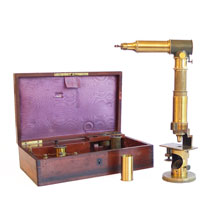
April 1840
Georg - Georges - Oberhaeuser
microscope coudé / Körpermikroscop mit einer größerer Platte
Paris, France
Signed on the tube "Georges Oberhaeuser, Place Dauphine № 19, à Paris". Comes with two letters from Oberhaeuser to Eduard Weber (1811-1871), who obtained in 1839 the degree of medical doctor in Heidelberg.
In the first letter of 9 April 1840, Oberhaeuser refers to this stand as "Körpermikroscop mit einer größerer Platte" (E: tubular microscope with a larger stage) or "microscope coudé" (E: horizontal microscope). In addition, Oberhaeuser writes "I still have some of the 12 camera lucida that I made at once". Contrary to an ordinary Oberhaeuser-type camera lucida, the example in this set comes with a protective cap that has no screw-end. This cap proved impractical and failed to protect the prism from damage.
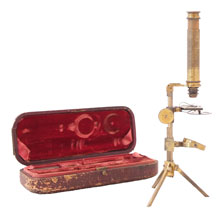
1834-49
Charles Chevalier
microscope diamant
Paris, France
Charles Chevalier named this pocket-sized instrument 'microscope diamant', because of its "small size and magnificent effect". Signed on the tube "Charles Chevalier, Palais Royal 163, Paris".
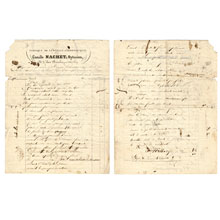
circa 1841
Camille Nachet
en-tête rue Boucher
Paris, France
A poem written on a paper with a very early Nachet letterhead: "FABRIQUE DE LENTILLES ACHROMATIQUES, Camille NACHET, Opticien, № 1, Rue Boucher près le Pont Neuf." At the time, this address must have been at the corner of the rue Monnaie.
Provenance: Marc Loury (1935-2014), great-great-grandson of Camille Nachet (1799-1881).

1842
Charles Chevalier
Catalogue des instrumens construits par Charles Chevalier
Paris, France
Chevalier's own in-house marked-up copy, interleaved and annotated. The majority of the annotations are in the hand of Charles Chevalier and relate to different suppliers (Pixii, Bourdon, Guillemain, Roget, Rouffet, Ruhmkorff, Marloye, Grau, Wauthier, Wiesnegg, ...) and their prices. Both title pages bear the signature "F. L. Chevalier 1878".
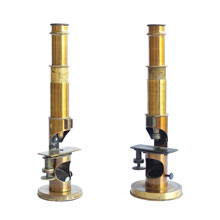
circa 1843
Achille Trécourt & Georg - Georges - Oberhaeuser
microscopes achromatiques réduits #644 & #656
Paris, France
These two small drum microscopes indicate that for some time Oberhaeuser was simultaneously selling microscopes under the name of his partnership with Trécourt and his name alone.
The microscope on the left is signed on the tube "Georges Oberhaeuser Place Dauphine, 19, Paris." and stamped on the base "644". The serial number 644 is also stamped onto the box.
The microscope on the right is signed on the base "TRÉCOURT ET GEORGES OBERHAEUSER, INGÉNIEURS BREVETÉS, PLACE DAUPHINE 19, PARIS. № 656".

1844
Alfred Nachet
La première enseigne de Nachet
Paris, France
Signboard used by Camille Nachet at the 1844 French Industrial Exhibition, made by his 13-year old son Alfred.
On the reverse side is written in the handwriting of Alfred: "La première enseigne de Nachet à l'Exposition de 1844, Alfred Nachet fecit" (E: "The first signboard of Nachet at the 1844 exhibition, Alfred Nachet fecit".)
Provenance: Marc Loury (1935-2014), great-grandson of Alfred Nachet (1831-1908).
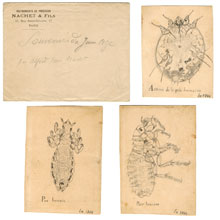
1844
Alfred Nachet
souvenirs du jeun âge
Paris, France
Micrographic drawings by the hand of the 13-year old Alfred Nachet, suggesting that he put to use his father's instruments.
Provenance: Marc Loury (1935-2014), great-grandson of Alfred Nachet (1831-1908).

circa 1845
Georg - Georges - Oberhaeuser
midsize drum microscope
Paris, France
Midsize drum microscope signed on one side of the arm "Georges Oberhaeuser, Ingénieur, Opticien, breveté, Place Dauphine, 19, Paris." and on the other side "Microscope achromatique. Platine à tourbillon. Eclairage à rayons parallèles. Diaphragme à mouvement vertical.". Confusingly, the top of the round base is signed "№ 696", while the bottom of the base is marked in ink "№ 969.". The box is stamped "969".
The nameplate on top of the box is signed in Gothic script "Dr. G. Boudet.", probably added at a slightly later date. Most likely referring to Marie-Claude-Gabriel Boudet (1829-1913) who obtained in 1856 the degree of medical doctor in Paris and returned to his birthplace Limoges.
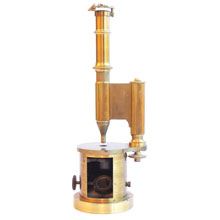
circa 1845
Georg - Georges - Oberhaeuser
large drum microscope
Paris, France
Large drum microscope signed on one side of the arm "Georges Oberhaeuser." and on the other side "Place Dauphine, 19 à Paris.". The top of the round base is signed "№ 994" and the bottom of the base is marked in ink "№ 994". The box is stamped "994".
This microscope originates from the pharmacy of Edouard Mercier (c. 1845 – c. 1912) in Nantua (Ain), which was taken over in 1914 by Jules Carrier (1881-1958). A grandchild of the latter sold the present microscope to this collection. Edouard Mercier took over the pharmacy of his father Benjamin Mercier (1811-1868), who obtained in 1836 the degree of pharmacist in Lyon.
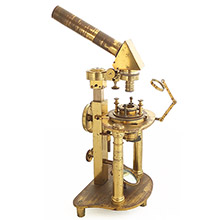
November 1845
Filippo Pacini & Giovanni Battista Amici
microscopio eseguito per Lord Vernon dal Prof. Amici secondo il modello del Prof. Pacini di Pisa
Florence, Italy
Microscope designed by Filippo Pacini and manufactured by Amici for George John Warren Vernon (1803-1866). When visiting Amici's workshop in Florence, Lord Vernon noticed Pacini's microscope being constructed (at present in the Museo Galileo, Florence) and asked Amici to make a second example.
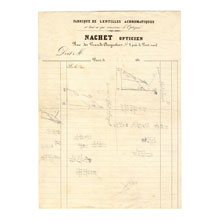
circa 1847
Camille Nachet
en-tête rue des Grands Augustins
Paris, France
Calculations for a prism on a paper with a Nachet letterhead: "FABRIQUE DE LENTILLES ACHROMATIQUES, et tout ce qui concerne l'Optique, NACHET Opticien, Rue des Grands Augustin, № 1, près le Pont-neuf." The prism was most likely intended for oblique illumination.
Provenance: Marc Loury (1935-2014), great-great-grandson of Camille Nachet (1799-1881).
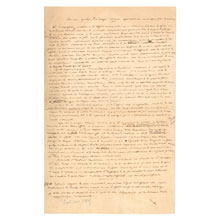
1847
Camille Nachet
un système d'éclairage oblique
Paris, France
Draft of a letter "Sur un système d'éclairage oblique applicable au microscope" by Camille Nachet to the French Academy of Sciences. The letter is reproduced in the proceedings of the Academy, session held on Monday 31 May 1847 (vol. 24, pp. 976-7).
Provenance: Marc Loury (1935-2014), great-great-grandson of Camille Nachet (1799-1881).

1847-50
Camille Nachet
microscope simple à dissection ou à doublet
Paris, France
Simple dissecting microscope by Nachet. Signed: "NACHET, Opticien, rue des Grands Augustins N°1". This stand is described and illustrated by Charles Robin in his 1849 book 'Du microscope et des injections' (pl. II, fig. 2, p. 60): "The base described and illustrated here fulfils far more the preceding conditions [...] than stands mounted onto the box which have to contain them".
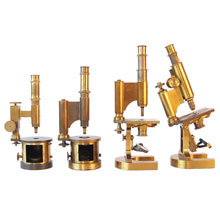
1837-62
Achille Trécourt & Georg Oberhäuser & Edmund Hartnack
development of the Continental form of microscope stand
Paris, France
On the left is a large drum-style microscope with revolving body, for which Trécourt and Oberhäuser obtained a patent in 1837. This design was initiated by Hercule Straus-Durckheim (1790-1865) for anatomical research.
Second is a circa 1842 example that shows some simplification: abolishment of the rack and pinion focus and the upper body could no longer swivel sideways.
The third is a horseshoe shape base microscope for which Oberhäuser received a patent in 1849. The base of the drum pattern was opened up to accept light from different angles.
On the right is a circa 1862 example showing the final steps taken by Hartnack in the development of the so-called Continental stand: introduction of a joint for inclination and coarse focusing by rack and pinion.
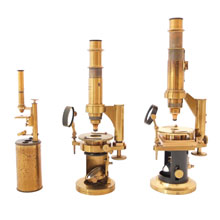
1845-55
Johann Joseph - Jean - Brunner
pocket, midsize and large microscope
Paris, France
The pocket microscope - mounted on top of its cylinder container - and the midsize model are both signed on the tube: "Brunner à Paris". The large model is signed on the tube: "Brunner, à Paris, 34, Rue des Bernardins".
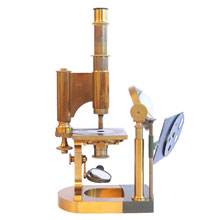
end of 1850
Georg - Georges - Oberhaeuser
microscope achromatique à miroir mobile
Paris, France
Large horseshoe base microscope. Signed on the arm "Georges Oberhaeuser" and "Place Dauphine, 19, Paris.". The tube is signed "№ 1879 breveté s[ans]. g[arantie].".
On 4 July 1849, Oberhaeuser requested a patent for a "microscope achromatique, à miroir mobile, donnant la lumière verticale et à toutes les obliquités, avec platine à mouvement circulaire fonctionnant sans déplacement de son axe optique", which he obtained on 17 September 1849.
According to Oberhaeuser, it was Abraham Abraham (c. 1799 - 1863) of Liverpool who brought "microscopes with mirrors outside of the optical axis" to his attention in 1846 and he "immediately started to make them". First described by Hugo von Mohl in his 1846 book 'Mikrographie' pp. 142-3.

circa 1850
Johann Theobald - Jean Thiébault - Silbermann
héliostat de Silbermann
Paris, France
Early Silbermann heliostat by Jules Duboscq. Signed on the drum: "J. T. Silbermann invtr. J. Duboscq - Soleil fecit. Paris, № 52" and on the clockwork: "PAUL GARNIER PARIS 2942".
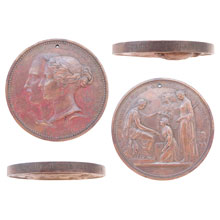
1851
Camille Nachet
Prize Medal
London, England
Prize Medal awarded to Camille Nachet at the Great Exhibition of 1851 in London. Inscribed around the edge: "PRIZE MEDAL OF THE EXHIBITION." and "NACHET. CLASS X.".
The 1852 ‘Reports by the Juries’ states: "Let us now turn our attention to the microscopes exhibited by France; and in first order is Natchet [sic]. The object-glasses, though inferior to both those of Ross, and Smith and Beck, are by far the best of the foreign ones." From these words and the fact that Charles Chevalier had to be content with an Honourable Mention, some modern historians conclude that in 1851 Nachet was the most ‘significant’ microscope manufacturer outside of England. In reality, Nachet had only started to make complete microscopes in 1847 and by 1851 Chevalier had completely shifted his focus from microscopy to photography. In 1851, the world's most productive microscope manufacturer was Georg Oberhäuser, who was based in Paris and did not attend the Great Exhibition.
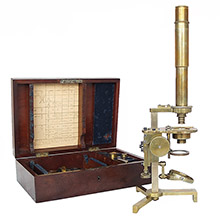
December 1851
Giovanni Battista Amici
microscopio commesso dal Conte di Rayneval ambasciatore di Francia in Roma
Florence, Italy
The microscope of Alphonse Gérard de Rayneval (1813-1858), French ambassador to the Vatican from 1850 to 1857. Shipped to Rome on 13 December 1851. The price, 535 francs, was paid for in March 1852 by a friend of Rayneval, Mario Massimo, duke of Rignano (1808-1873).
In 1868, Socrate Cadet (1808-1879) recalled that his 1854 microscopic observations on cholera were confirmed by "il conte Alfonso di Rayneval, in quel periodo ambasciadore di Francia presso la Sede Pontificia", to whom he referred as a "caldo coltivatore delle scienze naturali". It therefore appears that Rayneval put to use his microscope.
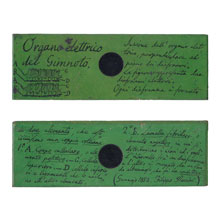
January 1852
Filippo Pacini
Organo elettrico del Gimnoto
Florence, Italy
As a by-product of his discovery of the corpuscules of touch - in 1843 named Pacinian corpuscles - Filippo Pacini (1812-1883) was led to study the electric organ in different fishes, in the hope of finding analogies with the functioning of human tactile organs. This study culminated in the publication in September 1852 of a paper on the "struttura intima dell' organo elettrico del gimnoto" [E: intimate structure of the electric organ of the electric eel]. The present microscope preparation labelled "Organo elettrico del Gimnoto" and dated January 1852 must have been made in preparation of the publication.
In 1854, when a deadly cholera epidemic struck Florence, Pacini's focus shifted completely to the vibrio cholerae.

1851-4
Camille Nachet
microscope à dissection de Lacaze-Duthiers
Paris, France
Dissecting microscope designed by Charles Robin with a tripod base conceived by Henri de Lacaze-Duthiers. Signed on the arm: "NACHET, Opticien, à Paris, Rue Serpente, 16". On pp. 68-9 of his 1849 book 'Du microscope et des injections' Robin observed: "As one of the arms of the [tripod] base is always directed towards the observer, it forces to lean forward to place the eye against the eyepiece, which renders it slightly more tiresome". The introduction of an inclined tube in the present microscope solved this problem.
Provenance: Marc Loury (1935-2014), great-great-grandson of Camille Nachet (1799-1881).
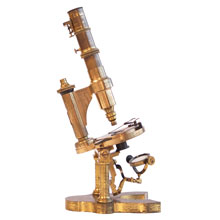
1851-3
Camille Nachet
nouveau microscope grand modèle
Paris, France
Signed on the arm: "NACHET, Opticien, à Paris, rue Serpente, 16".
In 1850, Nachet constructed Pieter Harting's "volledige verlichtingstoestel" (E: complete illuminating device), which included a mirror on an articulated arm and a moveable condenser carrier.
To implement Harting's substage illuminating device, Nachet introduced a new stand mounted on Roman pillars with a horseshoe foot. This design would become emblematic for Nachet and remain in use until well into the 1920s.
This prototype of the new large model differs from later examples by having a more complicated articulated arm holding the mirror and slightly different Roman pillars with a more elaborate base, including two toruses instead of one.
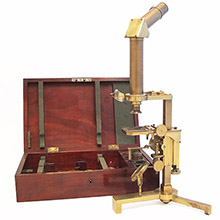
September 1853
Giovanni Battista Amici
microscopio per Signor Achille Brachet a Parigi
Florence, Italy
In 1852, the self-described "grand agitateur scientifique, rentier, physicien et homme de lettres" Achille Brachet (1820 - c. 1904) offered Amici no less than 2000 francs to make his best microscope ever. Amici eventually sold Brachet this 800 francs microscope with six series of phenomenal objectives. It was sent to Paris on 20 September 1853.
Brachet - who modelled himself on Marin Mersenne - ended up 'stalking' Amici, sending him letters under false names, causing Amici to classify Brachet as a "pazzo" and "testa sconvolta". In 1856, Brachet published a booklet on this microscope, which Pieter Harting in 1858 rightfully described as "tamelijk zonderling" (E: quite odd).
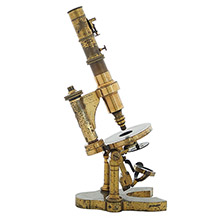
1853-4
Camille Nachet
microscope grand modèle
Paris, France
Early example of Nachet's 'large model' microscope. The working instrument of the London physician Frederick William Pavy (1829-1911). Signed on the arm: "NACHET, Opticien, à Paris, rue Serpente, 16" and on the case: "Dr F. W. Pavy". In 1853, like many British medical men, Pavy went to study medicine in Paris and returned to London the following year. This microscope dates from exactly that period.
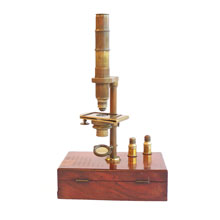
September 1857
Giovanni Battista Amici
microscopio piccolo commesso dal Sr Manganotti di Verona
Florence, Italy
Most likely the microscope ordered by Antonio Manganotti (1810-1892) for an unidentified friend. It comes with three series of objectives, of which one is for water immersion. It was this type of crude and humble microscope that Amici brought with him when he visited the 1855 Paris Exhibition and introduced his water immersion objective to the world.
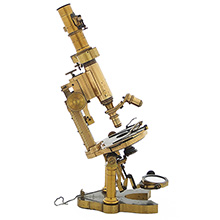
1857-60
Camille & Alfred Nachet
grand modèle perfectionné
Paris, France
Prototype of Nachet's 'large perfected model', most likely made for Frédéric Villot (1809-1875), curator of the Louvre Museum. Signed on the base: "NACHET ET FILS, Rue Serpente, 16, Paris". This prototype of the 'grand modèle perfectionné' includes quite a number of novelties, of which many did not survive in the production version. The coarse focusing is not by the usual rack and pinion, but by a chain winding round a spindle controlled by the wheels.
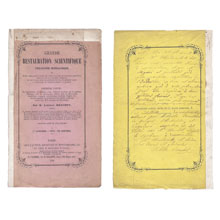
1859
Achille Brachet
Grande restauration scientifique
Paris, France
On the back cover of this weird pamphlet, Brachet - referring to himself as the "ogre of the opticians" -, wrote a remarkable message to Mr. Nachet: "M. Nachet est averti que M. Hartnack le bat dans ses nouvelles séries à immersion, et que M. Séguier est persuadé qu'à notre prochaine exposition de l'Industrie, ce sera cet estimable opticien qui à votre place, sera jugé être supérieur à tous les opticiens français. L'ogre des opticiens, ne va pas manquer de parler, dans son nouvel opuscule, des résultats incomparables obtenus par l'illustre successeur de Georges Oberhaeüser [sic], et s'exprimer combien il eût désiré voir M. Nachet adopter le système à immersion de M. Hartnack, et suivra ses traces si glorieuses.
Achille Brachet"
It is interesting to note that Nachet (or his descendants) cut off the attribution by the author on the front page. In addition, all pages are still uncut, apart from the first four.
Provenance: Marc Loury (1935-2014), great-grandson of Alfred Nachet (1831-1908).
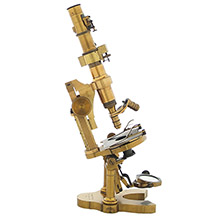
1860-2
Camille & Alfred Nachet
microscope grand modèle perfectionné
Paris, France
Early example of Nachet's 'large perfected model'. Signed on the base: "NACHET ET FILS, Rue Serpente, 16, Paris". Contrary to the prototype, in this production version the square vertical limb contains a rack and not a fusee chain. In addition, the body-tube arm and the tube can no longer be detached.
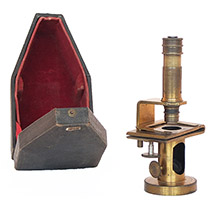
1858-63
Giovanni Battista Amici
microscopio tascabile
Florence, Italy
At the end of his life, Giovanni Battista Amici (1786-1863) started to manufacture this 'microscopio tascabile' (E: pocket microscope), hoping that "a portable microscope, with a volume as reduced as possible, with sufficient optical force, accessible to those with limited funds and made popular, would render useful services, especially in medicine and the natural sciences". Thirty years earlier, Georges Oberhaeuser combined the very same ingredients (drum stand and good optics) when he introduced his 'microscope achromatique réduit'. However, when compared to Oberhaeuser's small drum microscope, Amici's pocket microscope is just half in size (13 cm).
The present example comes with a box in the form of a coffin.
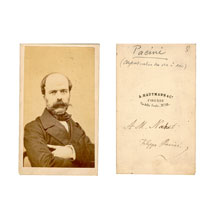
circa 1862
Filippo Pacini
portrait photo dedicated to Mr. Nachet
Florence, Italy
Portait photograph of Filippo Pacini by Anton Hautmann & Co. Signed and dedicated to Mr. Nachet.
Provenance: Marc Loury (1935-2014), great-grandson of Alfred Nachet (1831-1908).
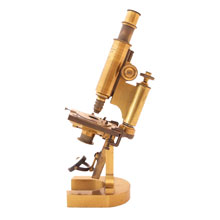
1862-3
Edmund - Edmond - Hartnack
nouveau grand modèle
Paris, France
After taking over Oberhäuser's workshop in 1860, Hartnack continued to manufacture Oberhäuser's models, all characterized by simplicity. The present microscope with serial number 4156 and signature "E. Hartnack, suc[cesseu]r de G. Oberhaeuser, Place Dauphine, 21, Paris. Breveté s[ans]. g[arantie]. d[u]. g[ouvernement]." demonstrates that in about 1862 Hartnack did find the courage to re-design Oberhäuser's large model, while still offering for sale the original model.
Below the stage Hartnack introduced a joint to allow the upper body to recline, which required the fine focusing screw to move from the bottom to the top of the pillar. Coarse adjustment by hand was replaced by rack and pinion, by means of two English design features. The tube is supported by a Lister limb and has a Jackson groove into which the focusing rack fitted.
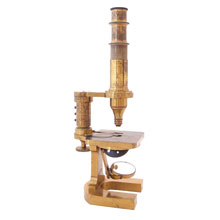
November 1863
Carl Zeiss
Stativ Ib. Grösseres zusammengesetztes Mikroskop
Jena, Germany
Early Zeiss microscope modelled after Oberhaeuser's horseshoe model. Signed on the arm "N. 155. Carl Zeiss Jena.". While manufactured in November 1863, it was only three years later, on 4 October 1866, that this microscope was supplied to the Belgian biologist Jean Baptiste Carnoy (1836-1899) in Tournai. Carnoy studied in Jena and came in touch with Zeiss.
It was only as late as in 1857 that Zeiss started to make compound microscopes.
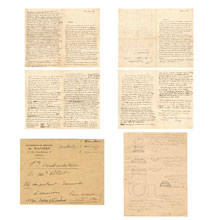
June 1865
Frédéric Villot
predecessor of Abbe condenser
Paris, France
Clockwise: Letter dated 12 June 1865 by Frédéric Villot (1809-1875) to Henri van Heurck (1838-1909) in which is written: "Do you know the excentric condenser of Nachet? The first that he made (6 or 8 years ago) was for me and in the meantime he has made others."
Additional letter of Villot to Van Heurck, dated 27 June 1865, in which Villot writes: "I only got my excentric illumination back yesterday. You will find enclosed the drawing and the dimensions. The latter are exact."
Villot's drawing of Nachet's substage condenser for oblique illumination. Van Heurck explicitly refers to this drawing on page 78 of his 1891 book 'Le Microscope' (p. 80 in 1893 English edition).
Envelope marked in Alfred Nachet's handwriting: "First condenser of Mr. Villot, very important document, to be kept (well before Abbe condenser)".
Provenance: Marc Loury (1935-2014), great-grandson of Alfred Nachet (1831-1908).

1867
Adam Prazmowski
demande de résidence permanente
Paris, France
Draft of Adam Prazmowski's 1867 application for permanent residence in France.
Prazmowski's entrance card for the 1867 Universal Exhibition in Paris that identifies him as an agent for Mr. Hartnack.
Circa 1867 portrait photos of Adam Prazmowski.
Provenance: Marc Loury (1935-2014), great-grandson of Alfred Nachet (1831-1908).

January 1873
Alfred Nachet
convocation des ouvriers de Monsieur Nachet
Paris, France
Convocation addressed to "Messieurs Les Ouvriers de Monsieur Nachet" (E: the workers of Mister Nachet) to attend the general meeting of the "Chambre Syndicale des Ouvriers Mécaniciens en Précision" (E: Union Chamber of Workers in Precision Mechanics) on Sunday, 19 January 1873.
Provenance: Marc Loury (1935-2014), great-grandson of Alfred Nachet (1831-1908).
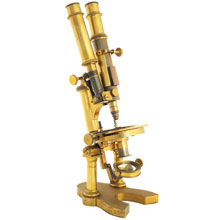
circa 1875
Camille & Alfred Nachet
binocular mineralogical microscope
Paris, France
At first sight this appears to be an ordinary binocular microscope by Nachet, but in reality it is a mineralogical microscope. Signed on the base: "NACHET ET FILS, 17, rue S[ain]t Séverin, Paris" and "GEOL. DEPT. U.C.D. DUBLIN 23". The vertical tube has a slot at its lower end allowing the introduction of an analyser. When of no use, the analyser in the vertical tube no longer had to be removed, thanks to the presence of a second inclined tube. In addition, the microscope comes with a rotating graduated stage suited for mineralogical research.
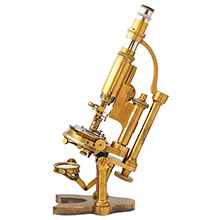
circa 1877
Camille & Alfred Nachet
microscope pour l'étude des roches
Paris, France
Circa 1877 petrological microscope by Nachet. Signed on the base: "NACHET ET FILS, 17, rue S[ain]t Séverin, Paris". The analyser was placed at the lower end of the internal tube and difficult to remove. Just above the objective, one finds an intriguing revolver holding different Bertrand lenses, allowing the use of convergent light.
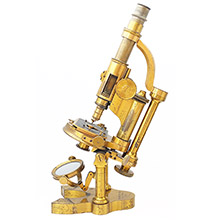
circa 1879
Camille & Alfred Nachet
microscope pour l'étude des roches
Paris, France
Circa 1879 petrological microscope by Nachet. Signed on the base: "NACHET ET FILS, 17, rue S[ain]t Séverin, Paris". This model represents a slightly improved design allowing the analyser to be freely removed from the tube. An absolutely identical instrument was used by the famous mineralogist Evgraf Stepanovich Fedorov and is depicted in his 1893 work 'Теодолитный метод в минералогии и петрографии' (E: Theodolite method in mineralogy and petrology).
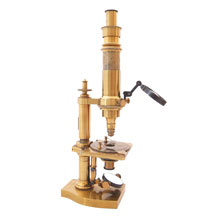
1880
Camille & Alfred Nachet
microscope petit modèle adapté à l'examen minéralogique des coupes de roches
Paris, France
Signed on the base: "NACHET ET FILS, 17, rue S[ain]t Séverin, Paris". The outside of the case is signed "Bleicher" and the inside "Ce microscope appartient à M. Ingold, de Colmar" (E: This microscope belongs to Mr. Ingold, of Colmar).
The Alsatian geologist and biologist, Gustave Bleicher (1838-1901) presented this "microscope Nachet, petit modèle, adapté à l'examen minéralogique des coupes de roches" at a meeting on 2 August 1880 to the members of the Société des sciences de Nancy.
In fact, this is a simplified mineralogical microscope made according to a design published in 1876 by Harry Rosenbusch (1836-1914). Rosenbusch commissioned Rudolf Fuess (1838-1917) in Berlin with the production of his microscope. The present example is most likely the first and only example made by Nachet.
After the assassination in 1901 of Bleicher at his Nancy laboratory by a pharmacist, this microscope apparently found its way to a nephew named Ingold, most likely Auguste Ingold (1852-1923).

prob. 1881
Alfred Nachet
mémorandum
Paris, France
Notes written by Alfred Nachet concerning his father Camille (1799-1881), stating: "Mr. Nachet père après avoir fabriqué pendant cinq six ans les objectifs lentilles à microscopes pour M. Ch. Chevalier avec lequel il était lié d'amitié s'établit en 1840 [...]". (E: "Mr. Nachet father, after having produced during five six years objectives lenses for microscopes for Mr. Ch. Chevalier to whom he was befriended, established himself in 1840 [...]".)
In 1929, when reproducing these notes in his catalogue 'Collection Nachet', Alfred's son Albert replaced Charles Chevalier with Vincent Chevalier.
Provenance: Marc Loury (1935-2014), great-grandson of Alfred Nachet (1831-1908).
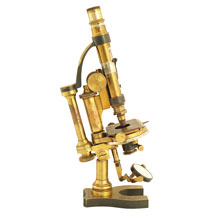
1881-90
Alfred Nachet
microscope moyen modèle de minéralogie et pétrographie
Paris, France
An early mid-size mineralogical microscope by Nachet. Signed on the base: "NACHET, 17, rue S[ain]t Séverin, Paris" and in the same script "Fac[ulté] des Sciences, Lab[oratoire] de Minéralogie, Lyon".

1883
Adam Prazmowski
affaire Prazmowski
Paris, France
Clockwise: Letter dated 7 October 1883 of Adam Prazmowski to Alfred Nachet, regarding the sale of his company. Included is a list of sales figures of the last five years.
Second letter dated 1 December 1883 to Nachet, in a different handwriting but signed by Prazmowski.
Envelope with the title "affaire Prazmowski" and the words "to be placed in the rue Saint Séverin archives".
Circa 1883 (auto)biographic manuscript of Adam Prazmoswki.
Circa 1883 portrait photos of Prazmowski.
Provenance: Marc Loury (1935-2014), great-grandson of Alfred Nachet (1831-1908).

1896
Bézu, Hausser & Cie
Liquidation de la société Bézu, Hausser & Cie
Paris, France
Clockwise: Act of sale between Bézu, Hausser et compagnie and Alfred Nachet of the optical firm "Ancienne maison Hartnack et Prazmowski", dated 9 April 1896. The selling price was 25 000 francs.
Turnover of the Bézu & Hausser company after the takeover by Nachet, between 9 April 1896 and 31 December 1896, including a list of debtors.
Receipt for purchase, dated 3 December 1897.
Provenance: Marc Loury (1935-2014), great-grandson of Alfred Nachet (1831-1908).

1901-2
Albert Nachet
historique de la maison Nachet
Paris, France
History of the Nachet company written by Albert Nachet in ink, corrections in pencil by Alfred Nachet.
These notes were reproduced in the 1901-1902 catalogue 'L'industrie française des instruments de précision' published by the French 'Syndicat des constructeurs en instruments d'optique & de précision' (p. 172), unfortunately without the corrections.
Provenance: Marc Loury (1935-2014), grandson of Albert Nachet (1863-1930).

1800-12
Bernardino Marzoli
microscopio acromatico solare
Brescia, Italy
Microscope by Bernardino Marzoli (1748-1835) with an achromatic plano-convex objective lens ground according to his 1808 paper "Sul modo di costruire le lenti acromatiche obbiettive dei microscopi composti".
The base has an intriguing signature: "Domenico Coccoli Fécit e inv. in Brixia". Domenico Cocoli (1747-1812) was a mathematics professor at the Lyceum of Brescia, from 1797 until at least 1807. In 1805 and 1808, Marzoli was recorded as "Conservatore del Gabinetto di Fisica" at the very same institution. The ink signature is not in the handwriting of Cocoli. Moreover, Cocoli invariably wrote his surname as "Cocoli" and not as "Coccoli". It therefore appears that the signature is incorrect.
The open circular base may have allowed a transformation into a solar microscope by mounting it onto a camera obscura. Marzoli exhibited such a combination in 1825 and donated it in 1834.

1812-4
Joseph Fraunhofer
zusammengesetztes Microscop, mit [...] vier achromatischen Objectiven [...] nebst Kästchen
Benediktbeuern, Germany
Early example of Fraunhofer's box-mounted achromatic microscope, made between November 1812 and February 1814. Signed on the stage "Utzschneider, Reichenbach, Fraunhofer in Bendictbeurn [sic]".
With the publication of his 1811 price list, Joseph Fraunhofer (1787-1826) was the first to truly commercialise an achromatic microscope. In fact, this list only offered one single compound microscope that was either available with uncorrected "einfachen Linsen" (E: simple lenses) or more expensive "achromatischen Linsen". The objective lenses of this microscope are achromatic and of a type nowadays named after Fraunhofer: an air-spaced bi-convex doublet.
As with all pre-Selligue dioptric achromatic microscopes, Fraunhofer's were of low power and no real improvement over an uncorrected compound microscope.

1819-22
Giovanni Battista Amici
microscopio a riflessione / microscopio catadiottrico
Modena, Italy
Reflecting or catadioptric microscope by G. B. Amici (1786-1863). Signed on the end of the tube: "Amici, Modena".
As it proved impossible to grind exceedingly small lenses with the required accuracy to form a high power achromatic lens-pair, in 1812 Amici turned his attention to the construction of reflecting microscopes. Reflectors are in principle free of aberrations, but difficult to fabricate. By 1818, Amici had developed a standardised form of his reflecting microscope, which he sold in quite considerable numbers. Amici's reflecting microscope truly represented an improvement over the uncorrected compound microscope.
It was only after being acquainted with Fresnel's 1824 favourable report on Selligue's microscope that Amici returned his attention to the fabrication of achromatic lens-pairs and eventually abolished the production of reflecting microscopes in 1829.

1824-5
Vincent Chevalier
microscope de Selligue
Paris, France
Selligue microscope by Vincent Chevalier (1770-1841), modernised by Hugh Powell (1799-1883) in the early 1830s. Most likely the instrument of the London surgeon John Howship (1781-1841). Signed on the tube "Selon M[onsieu]r Selligue, par Vincent Chevalier ainé, Ing[énieu]r Opt[ici]en Breveté, quai de L'horloge № 69 à Paris."
After returning from Geneva to his hometown Paris, Alexandre François Gilles a.k.a. Selligue (1784-1845), presented on April 5th 1824 to the French Academy of Sciences an achromatic microscope of "great simplicity. It is made up of two achromatic objectives which can be used simultaneously or separately". It was Selligue's explicit wish to make a microscope "that can be compared with that of Mr. Amici in all respects and does not have a single component that can not be made in all ordinary optical workshops." It was the 'ordinary optical workshop' of Vincent Chevalier that made the microscope presented by Selligue to the Academy.

circa 1826
Robert Aglaé Cauchoix
microscope de Selligue
Paris, France
Selligue microscope by Cauchoix. Signed on the tube "Cauchoix Opticien, à Paris".
In the introduction of the 1824 report on Selligue's achromatic microscope, Augustin Fresnel expressed his surprise that "up till now opticians have not applied achromatic combinations to microscopes, which they have been using for a long time for telescopes". Fresnel concluded that "Even though the new microscope is not equal to that of Amici in all respects, it nevertheless renders an important service to science by providing an instrument almost as perfect [...] that can be produced by ordinary methods, and which costs only 340 francs, while the price of the microscopes of Amici is 800 francs."
The present microscope shows that one of the two major Parisian manufacturers of achromatic telescopes - Cauchoix - did take up the production of achromatic microscopes after Selligue paved the way.

1829-31
Bouquet & Georges Oberhaeuser
microscope de M. Trécourt
Paris, France
Signed on the tube: "Bouquet et Georges Oberhaeuser, à Paris."
In about 1829, Achille Trécourt, a clerk in the French Ministry of War, designed what was - arguably - the first true low cost achromatic microscope. Trécourt entrusted the fabrication of the lenses of his 'microscope achromatique réduit' to Bouquet and the brasswork to the mechanical engineer Oberhäuser.
Contrary to later models, fine focusing in this example is not by tilting the stage, but is accomplished by turning a knurled sleeve in the middle of the tube.
The inside of the mirror cell is signed: "N° 19 Pour Mr Briquet". The name might refer to the Parisian physician and psychologist Pierre Briquet (1796-1881). Number 19 is a batch number stamped on different parts of the microscope.

end of 1830
Vincent & Charles Chevalier
microscope d'Amici
Paris, France
Horizontal microscope by Vincent & Charles Chevalier, in contemporary literature referred to as 'microscope d'Amici' (Amici type microscope). Signed on the tube "Vincent & C. Chevalier Ing[énieu]rs Opt[icie]ns, Quai de l'horloge № 69 à Paris" and on the tube cradle "CH. CHEVALIER, 154"

1834-5
Charles Chevalier
microscope chimique
Paris, France
An horizontal microscope that can be inverted for chemical use by Charles Chevalier (1804-1859). Most likely the instrument of Jean-Baptiste Biot (1774-1862). Signed on the tube: "Microscope Achromatique de Charles Chevalier, Ingénieur Opticien Breveté, Palais Royal 163 à Paris".
At the request of Félix Savart (1791-1842), Chevalier developed a new ‘universal’ microscope for the Collège de France, which was exhibited at the 1834 French Industrial Exposition. Shortly afterwards, Chevalier made a similar horizontal microscope for Biot that was "exclusively intended for chemical experiments". A second example of this new chemical microscope was made for Jean-Baptiste Dumas (1800-1884).
A label on the inside of the box states: "Vendu par Teigny, quai des Orfèvres 50. provenant du Dr de Brière, rue de La motte piquet." Adolphe-Louis Teigny was a retailer of scientific instruments active between 1855 and 1869. Dr de Brière remains unidentified.

1832-43
Achille Trécourt & Georg - Georges - Oberhaeuser
a myriad of 'microscopes achromatiques réduits'
Paris, France
Signed: "Trécourt & Georges Oberhaeuser, Place Dauphine № 19, Paris".
In about 1829, Trécourt formed a partnership with Oberhaeuser (mechanic) and Bouquet (optician) to make a cheap achromatic microscope. With great success: batch numbers on these microscopes are as high as 50, indicating that they were produced in large series.
In 1848, Oberhaeuser wrote to Pieter Harting: "if I ever rendered a service to science, it was by being the first to make inexpensive microscopes, so that scientists who are usually not rich can more easily open their wallet".

1837
Charles Chevalier
microscope universel petit modèle
Paris, France
In 1834, Charles Chevalier presented his 'universal microscope' that could be arranged as a vertical, horizontal and inverted (chemical) microscope. Its high price, however, was subject to criticism.
Chevalier took the criticism to heart and introduced in 1837 a smaller and cheaper universal model, based on his existing small 'simple and compound model'. He kept the tube, stage, mirror and optics, but added a second column, as well as two joints and a prism. Ironically, the resulting small universal model could be transformed into a simple microscope as well, contrary to the original and much more expensive large model.
In comparison to this very early unsigned example, later production models were one-third larger in size, had a drawtube, a double sided mirror, a stage that could be inverted and removable nosepieces.

August & October 1837
Achille Trécourt & Georg - Georges - Oberhaeuser
demande de brevet d'invention & brevet d'invention définitif
Paris, France
Patent application by Georges Oberhaeuser (Georg Oberhäuser) and Achille Trécourt for a "microscope achromatique vertical à miroir fixe avec platine à tourbillon...". Dated 17th August 1837.
In the margin of the first page of the patent application is written "Expédition". The example held by the Institut national de la propriété industrielle in Paris is marked on the very same location "Minute". It therefore appears that the present document was sent by the patent office to the applicants.
Final patent for a 5-year term, dated 13th October 1837.
Provenance: Marc Loury (1935-2014), great-grandson of Alfred Nachet (1831-1908).

circa 1837
Achille Trécourt & Georg - Georges - Oberhaeuser
microscope avec platine à tourbillon
Paris, France
Signed on the drum base "Brevet d'Invention, Trécourt & Georges Oberhaeuser, Place Dauphine № 19 à Paris". Trécourt and Oberhaeuser took out a patent for this 'microscope avec platine à tourbillon' in 1837.

August 1839
Giovanni Battista Amici
piccolo microscopio acromatico d'Amici acquistato dal S.r Coldwell di Dublino
Florence, Italy
The microscope of Robert Callwell a.k.a. Caldwell (c. 1800 - 1871), a banker from Dublin, Ireland. Callwell was one of the founders of the Dublin Microscopical Society in 1840.
Callwell's microscope was brought from Florence to Dublin by Gregory Sylvester Costigin a.k.a. Costigan (1817-1850), a stock and share broker.
Interestingly, Amici made Callwell pay 504 francs, which was almost double of the normal price for a small vertical microscope.
The microscope is designed in such a manner that by removing the tube it can be transformed into a simple microscope.

1837-42
Achille Trécourt & Georg - Georges - Oberhaeuser
evolution of the 'microscope avec platine à tourbillon'
Paris, France
In chronological order from left to right. The first four are signed on the drum base "Brevet d'Invention, Trécourt & Georges Oberhaeuser, Place Dauphine № 19 à Paris". The fourth bears an additional signature by its retailer: "A. Abraham, Liverpool.". The last one is signed on the arm: "Trécourt, & Georges Oberhaeuser, Place Dauphine № 19 à Paris. Brevet d'Invention, Microscope, Platine à Tourbillon.".

April 1840
Georg - Georges - Oberhaeuser
microscope coudé / Körpermikroscop mit einer größerer Platte
Paris, France
Signed on the tube "Georges Oberhaeuser, Place Dauphine № 19, à Paris". Comes with two letters from Oberhaeuser to Eduard Weber (1811-1871), who obtained in 1839 the degree of medical doctor in Heidelberg.
In the first letter of 9 April 1840, Oberhaeuser refers to this stand as "Körpermikroscop mit einer größerer Platte" (E: tubular microscope with a larger stage) or "microscope coudé" (E: horizontal microscope). In addition, Oberhaeuser writes "I still have some of the 12 camera lucida that I made at once". Contrary to an ordinary Oberhaeuser-type camera lucida, the example in this set comes with a protective cap that has no screw-end. This cap proved impractical and failed to protect the prism from damage.

1834-49
Charles Chevalier
microscope diamant
Paris, France
Charles Chevalier named this pocket-sized instrument 'microscope diamant', because of its "small size and magnificent effect". Signed on the tube "Charles Chevalier, Palais Royal 163, Paris".

circa 1841
Camille Nachet
en-tête rue Boucher
Paris, France
A poem written on a paper with a very early Nachet letterhead: "FABRIQUE DE LENTILLES ACHROMATIQUES, Camille NACHET, Opticien, № 1, Rue Boucher près le Pont Neuf." At the time, this address must have been at the corner of the rue Monnaie.
Provenance: Marc Loury (1935-2014), great-great-grandson of Camille Nachet (1799-1881).

1842
Charles Chevalier
Catalogue des instrumens construits par Charles Chevalier
Paris, France
Chevalier's own in-house marked-up copy, interleaved and annotated. The majority of the annotations are in the hand of Charles Chevalier and relate to different suppliers (Pixii, Bourdon, Guillemain, Roget, Rouffet, Ruhmkorff, Marloye, Grau, Wauthier, Wiesnegg, ...) and their prices. Both title pages bear the signature "F. L. Chevalier 1878".

circa 1843
Georg - Georges - Oberhaeuser
microscopes achromatiques réduits #644 & #656
Paris, France
These two small drum microscopes indicate that for some time Oberhaeuser was simultaneously selling microscopes under the name of his partnership with Trécourt and his name alone.
The microscope on the left is signed on the tube "Georges Oberhaeuser Place Dauphine, 19, Paris." and stamped on the base "644". The serial number 644 is also stamped onto the box.
The microscope on the right is signed on the base "TRÉCOURT ET GEORGES OBERHAEUSER, INGÉNIEURS BREVETÉS, PLACE DAUPHINE 19, PARIS. № 656".

1844
Alfred Nachet
La première enseigne de Nachet
Paris, France
Signboard used by Camille Nachet at the 1844 French Industrial Exhibition, made by his 13-year old son Alfred.
On the reverse side is written in the handwriting of Alfred: "La première enseigne de Nachet à l'Exposition de 1844, Alfred Nachet fecit" (E: "The first signboard of Nachet at the 1844 exhibition, Alfred Nachet fecit".)
Provenance: Marc Loury (1935-2014), great-grandson of Alfred Nachet (1831-1908).

1844
Alfred Nachet
souvenirs du jeun âge
Paris, France
Micrographic drawings by the hand of the 13-year old Alfred Nachet, suggesting that he put to use his father's instruments.
Provenance: Marc Loury (1935-2014), great-grandson of Alfred Nachet (1831-1908).

circa 1845
Georg - Georges - Oberhaeuser
midsize drum microscope
Paris, France
Midsize drum microscope signed on one side of the arm "Georges Oberhaeuser, Ingénieur, Opticien, breveté, Place Dauphine, 19, Paris." and on the other side "Microscope achromatique. Platine à tourbillon. Eclairage à rayons parallèles. Diaphragme à mouvement vertical.". Confusingly, the top of the round base is signed "№ 696", while the bottom of the base is marked in ink "№ 969.". The box is stamped "969".
The nameplate on top of the box is signed in Gothic script "Dr. G. Boudet.", probably added at a slightly later date. Most likely referring to Marie-Claude-Gabriel Boudet (1829-1913) who obtained in 1856 the degree of medical doctor in Paris and returned to his birthplace Limoges.

circa 1845
Georg - Georges - Oberhaeuser
large drum microscope
Paris, France
Large drum microscope signed on one side of the arm "Georges Oberhaeuser." and on the other side "Place Dauphine, 19 à Paris.". The top of the round base is signed "№ 994" and the bottom of the base is marked in ink "№ 994". The box is stamped "994".
This microscope originates from the pharmacy of Edouard Mercier (c. 1845 – c. 1912) in Nantua (Ain), which was taken over in 1914 by Jules Carrier (1881-1958). A grandchild of the latter sold the present microscope to this collection. Edouard Mercier took over the pharmacy of his father Benjamin Mercier (1811-1868), who obtained in 1836 the degree of pharmacist in Lyon.

November 1845
Filippo Pacini & Giovanni Battista Amici
microscopio eseguito per Lord Vernon dal Prof. Amici secondo il modello del Prof. Pacini di Pisa
Florence, Italy
Microscope designed by Filippo Pacini and manufactured by Amici for George John Warren Vernon (1803-1866). When visiting Amici's workshop in Florence, Lord Vernon noticed Pacini's microscope being constructed (at present in the Museo Galileo, Florence) and asked Amici to make a second example.

circa 1847
Camille Nachet
en-tête rue des Grands Augustins
Paris, France
Calculations for a prism on a paper with a Nachet letterhead: "FABRIQUE DE LENTILLES ACHROMATIQUES, et tout ce qui concerne l'Optique, NACHET Opticien, Rue des Grands Augustin, № 1, près le Pont-neuf." The prism was most likely intended for oblique illumination.
Provenance: Marc Loury (1935-2014), great-great-grandson of Camille Nachet (1799-1881).

1847
Camille Nachet
un système d'éclairage oblique
Paris, France
Draft of a letter "Sur un système d'éclairage oblique applicable au microscope" by Camille Nachet to the French Academy of Sciences. The letter is reproduced in the proceedings of the Academy, session held on Monday 31 May 1847 (vol. 24, pp. 976-7).
Provenance: Marc Loury (1935-2014), great-great-grandson of Camille Nachet (1799-1881).

1847-50
Camille Nachet
microscope simple à dissection ou à doublet
Paris, France
Simple dissecting microscope by Nachet. Signed: "NACHET, Opticien, rue des Grands Augustins N°1". This stand is described and illustrated by Charles Robin in his 1849 book 'Du microscope et des injections' (pl. II, fig. 2, p. 60): "The base described and illustrated here fulfils far more the preceding conditions [...] than stands mounted onto the box which have to contain them".

1837-62
Achille Trécourt & Georg Oberhäuser & Edmund Hartnack
development of the Continental form of microscope stand
Paris, France
On the left is a large drum-style microscope with revolving body, for which Trécourt and Oberhäuser obtained a patent in 1837. This design was initiated by Hercule Straus-Durckheim (1790-1865) for anatomical research.
Second is a circa 1842 example that shows some simplification: abolishment of the rack and pinion focus and the upper body could no longer swivel sideways.
The third is a horseshoe shape base microscope for which Oberhäuser received a patent in 1849. The base of the drum pattern was opened up to accept light from different angles.
On the right is a circa 1862 example showing the final steps taken by Hartnack in the development of the so-called Continental stand: introduction of a joint for inclination and coarse focusing by rack and pinion.

1845-55
Johann Joseph - Jean - Brunner
pocket, midsize and large microscope
Paris, France
The pocket microscope - mounted on top of its cylinder container - and the midsize model are both signed on the tube: "Brunner à Paris". The large model is signed on the tube: "Brunner, à Paris, 34, Rue des Bernardins".

end of 1850
Georg - Georges - Oberhaeuser
microscope achromatique à miroir mobile
Paris, France
Large horseshoe base microscope. Signed on the arm "Georges Oberhaeuser" and "Place Dauphine, 19, Paris.". The tube is signed "№ 1879 breveté s[ans]. g[arantie].".
On 4 July 1849, Oberhaeuser requested a patent for a "microscope achromatique, à miroir mobile, donnant la lumière verticale et à toutes les obliquités, avec platine à mouvement circulaire fonctionnant sans déplacement de son axe optique", which he obtained on 17 September 1849.
According to Oberhaeuser, it was Abraham Abraham (c. 1799 - 1863) of Liverpool who brought "microscopes with mirrors outside of the optical axis" to his attention in 1846 and he "immediately started to make them". First described by Hugo von Mohl in his 1846 book 'Mikrographie' pp. 142-3.

circa 1850
Johann Theobald - Jean Thiébault - Silbermann
héliostat de Silbermann
Paris, France
Early Silbermann heliostat by Jules Duboscq. Signed on the drum: "J. T. Silbermann invtr. J. Duboscq - Soleil fecit. Paris, № 52" and on the clockwork: "PAUL GARNIER PARIS 2942".

1851
Camille Nachet
Prize Medal
London, England
Prize Medal awarded to Camille Nachet at the Great Exhibition of 1851 in London. Inscribed around the edge: "PRIZE MEDAL OF THE EXHIBITION." and "NACHET. CLASS X.".
The 1852 ‘Reports by the Juries’ states: "Let us now turn our attention to the microscopes exhibited by France; and in first order is Natchet [sic]. The object-glasses, though inferior to both those of Ross, and Smith and Beck, are by far the best of the foreign ones." From these words and the fact that Charles Chevalier had to be content with an Honourable Mention, some modern historians conclude that in 1851 Nachet was the most ‘significant’ microscope manufacturer outside of England. In reality, Nachet had only started to make complete microscopes in 1847 and by 1851 Chevalier had completely shifted his focus from microscopy to photography. In 1851, the world's most productive microscope manufacturer was Georg Oberhäuser, who was based in Paris and did not attend the Great Exhibition.

December 1851
Giovanni Battista Amici
microscopio commesso dal Conte di Rayneval ambasciatore di Francia in Roma
Florence, Italy
The microscope of Alphonse Gérard de Rayneval (1813-1858), French ambassador to the Vatican from 1850 to 1857. Shipped to Rome on 13 December 1851. The price, 535 francs, was paid for in March 1852 by a friend of Rayneval, Mario Massimo, duke of Rignano (1808-1873).
In 1868, Socrate Cadet (1808-1879) recalled that his 1854 microscopic observations on cholera were confirmed by "il conte Alfonso di Rayneval, in quel periodo ambasciadore di Francia presso la Sede Pontificia", to whom he referred as a "caldo coltivatore delle scienze naturali". It therefore appears that Rayneval put to use his microscope.

January 1852
Filippo Pacini
Organo elettrico del Gimnoto
Florence, Italy
As a by-product of his discovery of the corpuscules of touch - in 1843 named Pacinian corpuscles - Filippo Pacini (1812-1883) was led to study the electric organ in different fishes, in the hope of finding analogies with the functioning of human tactile organs. This study culminated in the publication in September 1852 of a paper on the "struttura intima dell' organo elettrico del gimnoto" [E: intimate structure of the electric organ of the electric eel]. The present microscope preparation labelled "Organo elettrico del Gimnoto" and dated January 1852 must have been made in preparation of the publication.
In 1854, when a deadly cholera epidemic struck Florence, Pacini's focus shifted completely to the vibrio cholerae.

1851-4
Camille Nachet
microscope à dissection de Lacaze-Duthiers
Paris, France
Dissecting microscope designed by Charles Robin with a tripod base conceived by Henri de Lacaze-Duthiers. Signed on the arm: "NACHET, Opticien, à Paris, Rue Serpente, 16". On pp. 68-9 of his 1849 book 'Du microscope et des injections' Robin observed: "As one of the arms of the [tripod] base is always directed towards the observer, it forces to lean forward to place the eye against the eyepiece, which renders it slightly more tiresome". The introduction of an inclined tube in the present microscope solved this problem.
Provenance: Marc Loury (1935-2014), great-great-grandson of Camille Nachet (1799-1881).

1851-3
Camille Nachet
nouveau microscope grand modèle
Paris, France
Signed on the arm: "NACHET, Opticien, à Paris, rue Serpente, 16".
In 1850, Nachet constructed Pieter Harting's "volledige verlichtingstoestel" (E: complete illuminating device), which included a mirror on an articulated arm and a moveable condenser carrier.
To implement Harting's substage illuminating device, Nachet introduced a new stand mounted on Roman pillars with a horseshoe foot. This design would become emblematic for Nachet and remain in use until well into the 1920s.
This prototype of the new large model differs from later examples by having a more complicated articulated arm holding the mirror and slightly different Roman pillars with a more elaborate base, including two toruses instead of one.

September 1853
Giovanni Battista Amici
microscopio per Signor Achille Brachet a Parigi
Florence, Italy
In 1852, the self-described "grand agitateur scientifique, rentier, physicien et homme de lettres" Achille Brachet (1820 - c. 1904) offered Amici no less than 2000 francs to make his best microscope ever. Amici eventually sold Brachet this 800 francs microscope with six series of phenomenal objectives. It was sent to Paris on 20 September 1853.
Brachet - who modelled himself on Marin Mersenne - ended up 'stalking' Amici, sending him letters under false names, causing Amici to classify Brachet as a "pazzo" and "testa sconvolta". In 1856, Brachet published a booklet on this microscope, which Pieter Harting in 1858 rightfully described as "tamelijk zonderling" (E: quite odd).

1853-4
Camille Nachet
microscope grand modèle
Paris, France
Early example of Nachet's 'large model' microscope. The working instrument of London physician Frederick William Pavy (1829-1911). Signed on the arm: "NACHET, Opticien, à Paris, rue Serpente, 16" and on the case: "Dr F. W. Pavy". In 1853, like many British medical men, Pavy went to study medicine in Paris and returned to London the following year. This microscope dates from exactly that period.

September 1857
Giovanni Battista Amici
microscopio piccolo commesso dal Sr Manganotti di Verona
Florence, Italy
Most likely the microscope ordered by Antonio Manganotti (1810-1892) for an unidentified friend. It comes with three series of objectives, of which one is for water immersion. It was this type of crude and humble microscope that Amici brought with him when he visited the 1855 Paris Exhibition and introduced his water immersion objective to the world.

1857-60
Camille & Alfred Nachet
microscope grand modèle perfectionné
Paris, France
Prototype of Nachet's 'large perfected model', most likely made for Frédéric Villot (1809-1875), curator of the Louvre Museum. Signed on the base: "NACHET ET FILS, Rue Serpente, 16, Paris". This prototype of the 'grand modèle perfectionné' includes quite a number of novelties, of which many did not survive in the production version. The coarse focusing is not by the usual rack and pinion, but by a chain winding round a spindle controlled by the wheels.

1859
Achille Brachet
Grande restauration scientifique
Paris, France
On the back cover of this weird pamphlet, Brachet - referring to himself as the "ogre of the opticians" -, wrote a remarkable message to Mr. Nachet: "M. Nachet est averti que M. Hartnack le bat dans ses nouvelles séries à immersion, et que M. Séguier est persuadé qu'à notre prochaine exposition de l'Industrie, ce sera cet estimable opticien qui à votre place, sera jugé être supérieur à tous les opticiens français. L'ogre des opticiens, ne va pas manquer de parler, dans son nouvel opuscule, des résultats incomparables obtenus par l'illustre successeur de Georges Oberhaeüser [sic], et s'exprimer combien il eût désiré voir M. Nachet adopter le système à immersion de M. Hartnack, et suivra ses traces si glorieuses.
Achille Brachet"
It is interesting to note that Nachet (or his descendants) cut off the attribution by the author on the front page. In addition, all pages are still uncut, apart from the first four.
Provenance: Marc Loury (1935-2014), great-grandson of Alfred Nachet (1831-1908).

1860-2
Camille & Alfred Nachet
microscope grand modèle perfectionné
Paris, France
Early example of Nachet's 'large perfected model'. Signed on the base: "NACHET ET FILS, Rue Serpente, 16, Paris". Contrary to the prototype, in this production version the square vertical limb contains a rack and not a fusee chain. In addition, the body-tube arm and the tube can no longer be detached.

1858-63
Giovanni Battista Amici
microscopio tascabile
Florence, Italy
At the end of his life, Giovanni Battista Amici (1786-1863) started to manufacture this 'microscopio tascabile' (E: pocket microscope), hoping that "a portable microscope, with a volume as reduced as possible, with sufficient optical force, accessible to those with limited funds and made popular, would render useful services, especially in medicine and the natural sciences". Thirty years earlier, Georges Oberhaeuser combined the very same ingredients (drum stand and good optics) when he introduced his 'microscope achromatique réduit'. However, when compared to Oberhaeuser's small drum microscope, Amici's pocket microscope is just half in size (13 cm).
The present example comes with a box in the form of a coffin.

circa 1862
Filippo Pacini
portrait photo dedicated to Mr. Nachet
Florence, Italy
Portait photograph of Filippo Pacini by Anton Hautmann & Co. Signed and dedicated to Mr. Nachet.
Provenance: Marc Loury (1935-2014), great-grandson of Alfred Nachet (1831-1908).

1862-3
Edmund - Edmond - Hartnack
nouveau grand modèle
Paris, France
After taking over Oberhäuser's workshop in 1860, Hartnack continued to manufacture Oberhäuser's models, all characterized by simplicity. The present microscope with serial number 4156 and signature "E. Hartnack, suc[cesseu]r de G. Oberhaeuser, Place Dauphine, 21, Paris. Breveté s[ans]. g[arantie]. d[u]. g[ouvernement]." demonstrates that in about 1862 Hartnack did find the courage to re-design Oberhäuser's large model, while still offering for sale the original model.
Below the stage Hartnack introduced a joint to allow the upper body to recline, which required the fine focusing screw to move from the bottom to the top of the pillar. Coarse adjustment by hand was replaced by rack and pinion, by means of two English design features. The tube is supported by a Lister limb and has a Jackson groove into which the focusing rack fitted.

November 1863
Carl Zeiss
Stativ Ib. Grösseres zusammengesetztes Mikroskop
Jena, Germany
Early Zeiss microscope modelled after Oberhaeuser's horseshoe model. Signed on the arm "N. 155. Carl Zeiss Jena.". While manufactured in November 1863, it was only three years later, on 4 October 1866, that this microscope was supplied to the Belgian biologist Jean Baptiste Carnoy (1836-1899) in Tournai. Carnoy studied in Jena and came in touch with Zeiss.
It was only as late as in 1857 that Zeiss started to make compound microscopes.

June 1865
Frédéric Villot
predecessor of Abbe condenser
Paris, France
From left to right: Letter dated 12 June 1865 by Frédéric Villot (1809-1875) to Henri van Heurck (1838-1909) in which is written: "Do you know the excentric condenser of Nachet? The first that he made (6 or 8 years ago) was for me and in the meantime he has made others."
Additional letter of Villot to Van Heurck, dated 27 June 1865, in which Villot writes: "I only got my excentric illumination back yesterday. You will find enclosed the drawing and the dimensions. The latter are exact."
Villot's drawing of Nachet's substage condenser for oblique illumination. Van Heurck explicitly refers to this drawing on page 78 of his 1891 book 'Le Microscope' (p. 80 in 1893 English edition).
Envelope marked in Alfred Nachet's handwriting: "First condenser of Mr. Villot, very important document, to be kept (well before Abbe condenser)".
Provenance: Marc Loury (1935-2014), great-grandson of Alfred Nachet (1831-1908).

1867
Adam Prazmowski
demande de résidence permanente
Paris, France
Draft of Adam Prazmowski's 1867 application for permanent residence in France.
Prazmowski's entrance card for the 1867 Universal Exhibition in Paris that identifies him as an agent for Mr. Hartnack.
Circa 1867 portrait photos of Adam Prazmowski.
Provenance: Marc Loury (1935-2014), great-grandson of Alfred Nachet (1831-1908).

January 1873
Alfred Nachet
convocation des ouvriers de Monsieur Nachet
Paris, France
Convocation addressed to "Messieurs Les Ouvriers de Monsieur Nachet" (E: the workers of Mister Nachet) to attend the general meeting of the "Chambre Syndicale des Ouvriers Mécaniciens en Précision" (E: Union Chamber of Workers in Precision Mechanics) on Sunday, 19 January 1873.
Provenance: Marc Loury (1935-2014), great-grandson of Alfred Nachet (1831-1908).

circa 1875
Camille & Alfred Nachet
binocular mineralogical microscope
Paris, France
At first sight this appears to be an ordinary binocular microscope by Nachet, but in reality it is a mineralogical microscope. Signed on the base: "NACHET ET FILS, 17, rue S[ain]t Séverin, Paris" and "GEOL. DEPT. U.C.D. DUBLIN 23". The vertical tube has a slot at its lower end allowing the introduction of an analyser. When of no use, the analyser in the vertical tube no longer had to be removed, thanks to the presence of a second inclined tube. In addition, the microscope comes with a rotating graduated stage suited for mineralogical research.

circa 1877
Camille & Alfred Nachet
microscope pour l'étude des roches
Paris, France
Circa 1877 mineralogical microscope by Nachet. Signed on the base: "NACHET ET FILS, 17, rue S[ain]t Séverin, Paris". The analyser was placed at the lower end of the internal tube and difficult to remove. Just above the objective, one finds an intriguing revolver holding different Bertrand lenses, allowing the use of convergent light.

circa 1879
Camille & Alfred Nachet
microscope pour l'étude des roches
Paris, France
Circa 1879 mineralogical microscope by Nachet. Signed on the base: "NACHET ET FILS, 17, rue S[ain]t Séverin, Paris". This model represents a slightly improved design allowing the analyser to be freely removed from the tube. An absolutely identical instrument was used by the famous mineralogist Evgraf Stepanovich Fedorov and is depicted in his 1893 work 'Теодолитный метод в минералогии и петрографии' (E: Theodolite method in mineralogy and petrology).

1880
Camille & Alfred Nachet
microscope petit modèle adapté à l'examen minéralogique des coupes de roches
Paris, France
Signed on the base: "NACHET ET FILS, 17, rue S[ain]t Séverin, Paris". The outside of the case is signed "Bleicher" and the inside "Ce microscope appartient à M. Ingold, de Colmar" (E: This microscope belongs to Mr. Ingold, of Colmar).
The Alsatian geologist and biologist, Gustave Bleicher (1838-1901) presented this "microscope Nachet, petit modèle, adapté à l'examen minéralogique des coupes de roches" at a meeting on 2 August 1880 to the members of the Société des sciences de Nancy.
In fact, this is a simplified mineralogical microscope made according to a design published in 1876 by Harry Rosenbusch (1836-1914). Rosenbusch commissioned Rudolf Fuess (1838-1917) in Berlin with the production of his microscope. The present example is most likely the first and only example made by Nachet.
After the assassination in 1901 of Bleicher at his Nancy laboratory by a pharmacist, this microscope apparently found its way to a nephew named Ingold, most likely Auguste Ingold (1852-1923).

prob. 1881
Alfred Nachet
mémorandum
Paris, France
Notes written by Alfred Nachet concerning his father Camille (1799-1881), stating: "Mr. Nachet père après avoir fabriqué pendant cinq six ans les objectifs lentilles à microscopes pour M. Ch. Chevalier avec lequel il était lié d'amitié s'établit en 1840 [...]". (E: "Mr. Nachet father, after having produced during five six years objectives lenses for microscopes for Mr. Ch. Chevalier to whom he was befriended, established himself in 1840 [...]".)
In 1929, when reproducing these notes in his catalogue 'Collection Nachet', Alfred's son Albert replaced Charles Chevalier with Vincent Chevalier.
Provenance: Marc Loury (1935-2014), great-grandson of Alfred Nachet (1831-1908).

1881-90
Alfred Nachet
microscope moyen modèle de minéralogie et pétrographie
Paris, France
An early mid-size mineralogical microscope by Nachet. Signed on the base: "NACHET, 17, rue S[ain]t Séverin, Paris" and in the same script "Fac[ulté] des Sciences, Lab[oratoire] de Minéralogie, Lyon".

1883
Adam Prazmowski
affaire Prazmowski
Paris, France
Clockwise: Letter dated 7 October 1883 of Adam Prazmowski to Alfred Nachet, regarding the sale of his company. Included is a list of sales figures of the last five years.
Second letter dated 1 December 1883 to Nachet, in a different handwriting but signed by Prazmowski.
Envelope with the title "affaire Prazmowski" and the words "to be placed in the rue Saint Séverin archives".
Circa 1883 (auto)biographic manuscript of Adam Prazmoswki.
Circa 1883 portrait photos of Prazmowski.
Provenance: Marc Loury (1935-2014), great-grandson of Alfred Nachet (1831-1908).

1896
Bézu, Hausser & Cie
Liquidation de la société Bézu, Hausser & Cie
Paris, France
Clockwise: Act of sale between Bézu, Hausser et compagnie and Alfred Nachet of the optical firm "Ancienne maison Hartnack et Prazmowski", dated 9 April 1896. The selling price was 25 000 francs.
Turnover of the Bézu & Hausser company after the takeover by Nachet, between 9 April 1896 and 31 December 1896, including a list of debtors.
Receipt for purchase, dated 3 December 1897.
Provenance: Marc Loury (1935-2014), great-grandson of Alfred Nachet (1831-1908).

1901-2
Albert Nachet
historique de la maison Nachet
Paris, France
History of the Nachet company written by Albert Nachet in ink, corrections in pencil by Alfred Nachet.
These notes were reproduced in the 1901-1902 catalogue 'L'industrie française des instruments de précision' published by the French 'Syndicat des constructeurs en instruments d'optique & de précision' (p. 172), unfortunately without the corrections.
Provenance: Marc Loury (1935-2014), grandson of Albert Nachet (1863-1930).